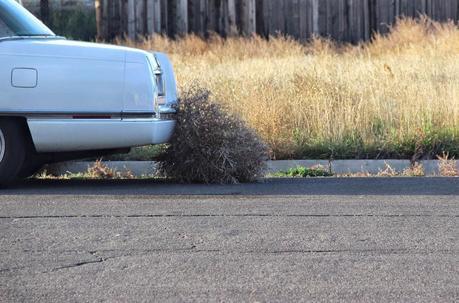 Tumbleweeds are integral to our beloved American West -- a land of wide open spaces where tumbleweeds, cowboys and other free spirits can go wherever the wind takes them. They symbolize the revered rugged individualist -- loyal only to his own personal code.
Tumbleweeds are integral to our beloved American West -- a land of wide open spaces where tumbleweeds, cowboys and other free spirits can go wherever the wind takes them. They symbolize the revered rugged individualist -- loyal only to his own personal code.Lonely but free I'll be found ... drifting along with the tumbling tumbleweeds.
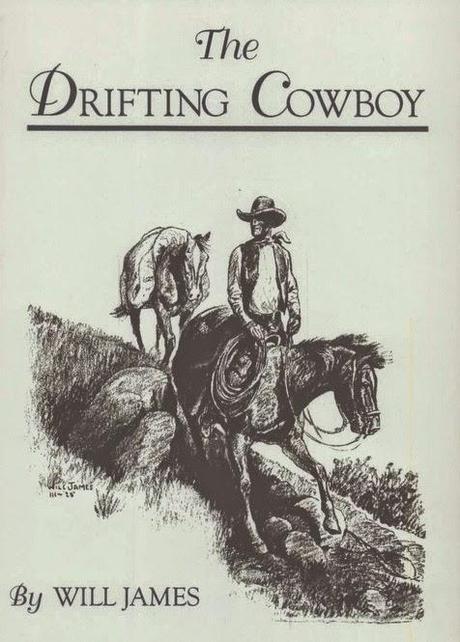
The Drifting Cowboy (Tumbleweed Series), 1925. Source.
But truth be known -- tumbleweeds are foreigners. They snuck in from Eurasia, probably in the 1800s in “contaminated” feed. And contrary to Western myth, they do just fine within the confines of town. So when Lucy Corrander offered to host a virtual Street Plants gathering, urban tumbleweeds came to mind.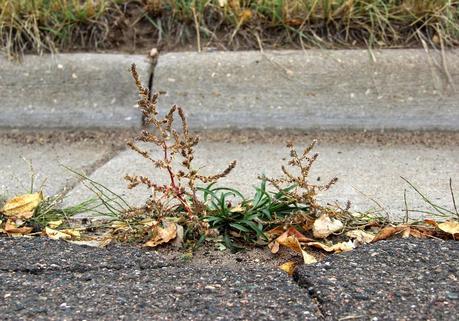
Tumbleweeds grow as the situation demands -- small in small spots, bigger where there's more space.
The “tumble” in their name comes from what they do. These are traveling plants. After they die and dry out each fall (being annuals), they break loose and tumble along, blown by the wind. Seeds fall out along the way, or wherever the tumbleweeds land -- lodged against fences, under cars, or in trees.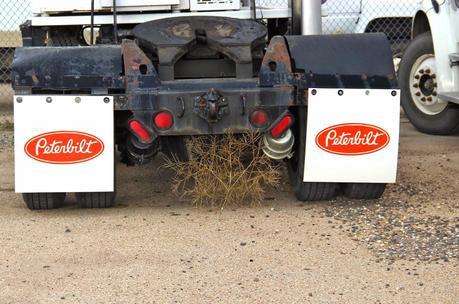 The “weed” part of their name means they’re unwelcome. That's due largely to their fecundity, which is astonishing (more below). The results can be overwhelming ... as when unwelcome tumbleweeds invaded Clovis, New Mexico. Neither man nor machine could handle the unruly plants.Based on yearly inventories of my hedge, trees and fences, three species of tumbleweed inhabit our neighborhood. Most common by far is kochia or summer cypress (Kochia scoparia). Mature plants range from a single short stem to robust branching individuals up to six feet tall. In a good year, a large plant may produce 50,000 seeds; the average is 14,600 (source). And that’s a relatively small tumbleweed family! (more below).
The “weed” part of their name means they’re unwelcome. That's due largely to their fecundity, which is astonishing (more below). The results can be overwhelming ... as when unwelcome tumbleweeds invaded Clovis, New Mexico. Neither man nor machine could handle the unruly plants.Based on yearly inventories of my hedge, trees and fences, three species of tumbleweed inhabit our neighborhood. Most common by far is kochia or summer cypress (Kochia scoparia). Mature plants range from a single short stem to robust branching individuals up to six feet tall. In a good year, a large plant may produce 50,000 seeds; the average is 14,600 (source). And that’s a relatively small tumbleweed family! (more below).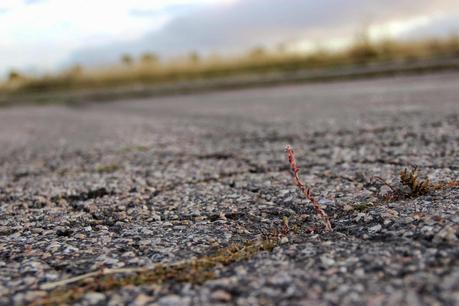
Tiny kochia waif takes back the street.
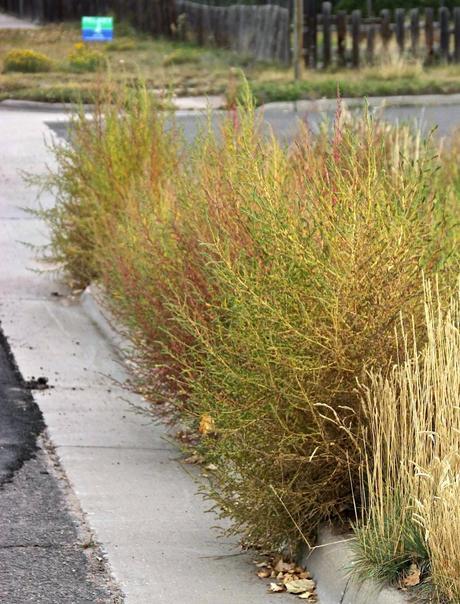
Robust summer cypress, all decked out in fall colors.
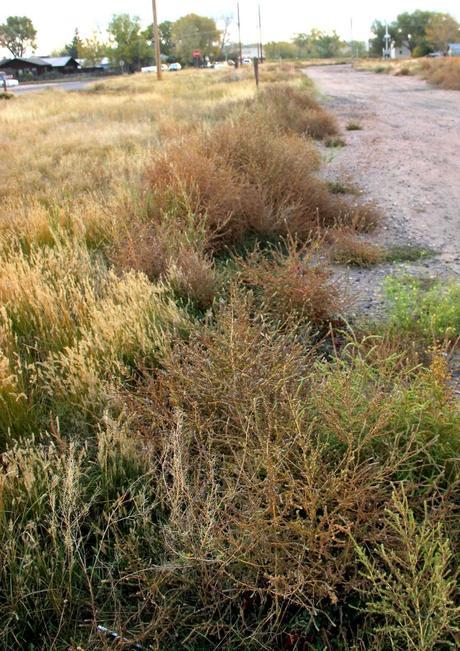
Kochia hedge, drying in preparation for travel.
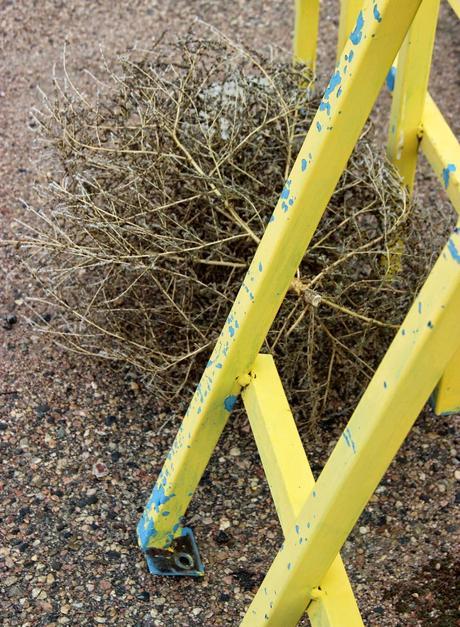
Kochia showing broken-off stem. There’s a separation or abscission zone near the base of each plant.
Russian thistle (Salsola kali, S. tragus or Kali tragus) is the “tumbleweed” of Western legend, though in our neighborhood it’s not even half as common as kochia. Mature plants may be up to five feet in diameter, and are oval to round -- made to roll.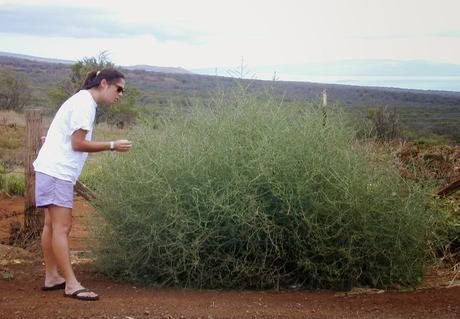
Photo by Forest & Kim Starr, via Wikipedia.
Like kochia, Russian thistle scatters seeds as it tumbles along. But the winged seeds can travel with the wind too, independent of their parents. The reproductive output of this tumbleweed is massive -- a "typical" plant sows 250,000 seeds (source).See them tumbling down ... pledging their love to the ground
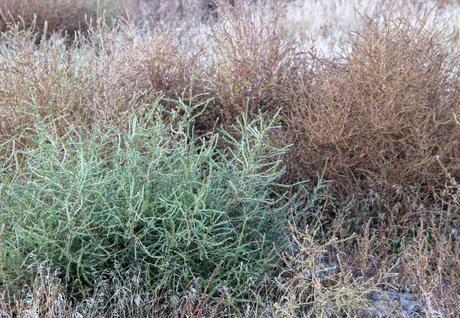
Green Russian thistle, with drying summer cypress to right and behind.
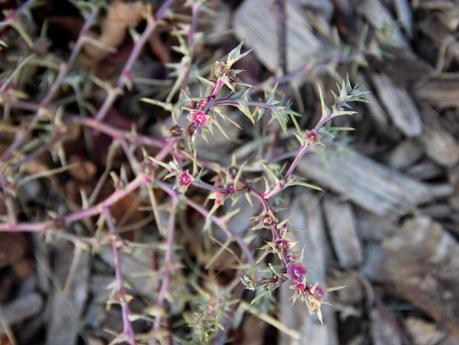
Maturing Russian thistle has a beauty to it -- pink and green and a bit fleshy.
The small leaves of Russian thistle are sharp-tipped when young, get even sharper with age (above), and become hard and penetrating when dry. Lambs get mouth sores if they eat dried tumbleweeds, and cowboys wear leather gloves to clean them from fences.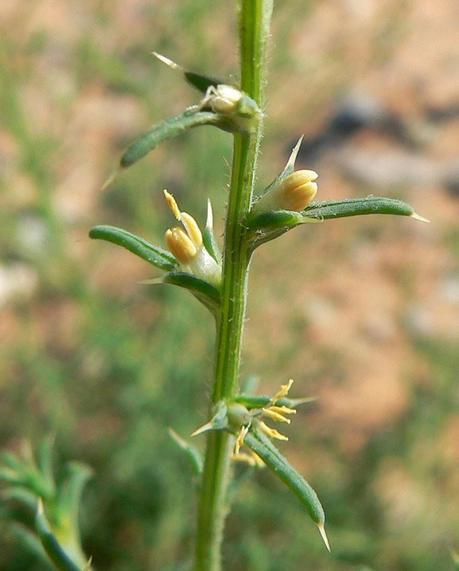
Young Russian thistle with flowers in leaf axils. Photo by
Stan Shebs; source.
Tumble mustard (Erysimum altissimum) is the least common and least familiar of our tumbleweeds, but look around and you’ll always find some. In fact, my yard inventories show it to be almost as common as Russian thistle. Plants are similar to Russian thistle in size but are even more fecund -- a single plant is said to produce up to 1.5 million seeds -- unbelievable! Tumble mustard has several adaptations not found in the other tumbleweeds. Their pods shatter slowly, so seeds are scattered farther afield as the plant tumbles. Kochia and Russian thistle seeds don’t survive more than a year, but tumble mustard can generate sizable seedbanks lasting 40 years or more (source).
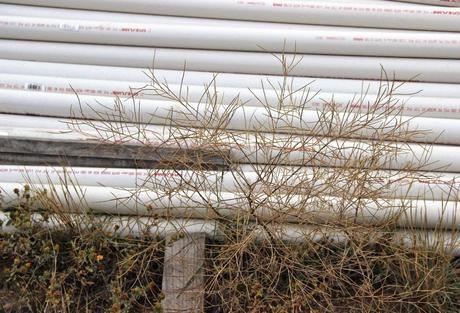
Last year a tumble mustard dropped seeds by these PVC pipes. Now an offspring is ready to take off.

There’s a nice geometry to tumble mustards, with their wide branching. Thin green structures are seedpods.
In the photo below, all three tumbleweeds line up side-by-side, with many more behind. Soon they'll break loose and roam ... drifting east with the wind.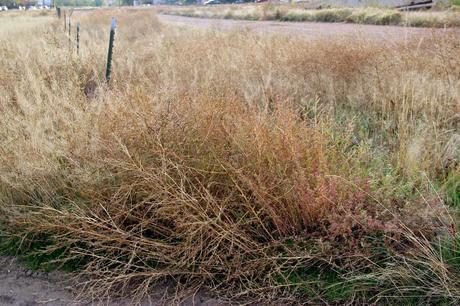
Left to right: tumble mustard, kochia and Russian thistle.
I'm a roaming cowboy riding all day long ... tumbleweeds around me sing their lonely song. Nights underneath the prairie moon ... I ride along and sing this tune:Tumbling Tumbleweeds, written by Bob Nolan, 1930s.
